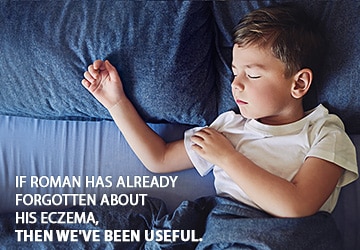Why treat baby’s eczema?
Baby’s eczema is an alternation between inflammatory flare-ups and periods of remission. In eczema, the baby's skin becomes covered with red plaques on the face and/or body. To relieve themselves, the babies rub against the sheets and wriggle. They cry a lot and sleep poorly because of the itching and discomfort. Parents are often distressed.
Treating baby's eczema not only helps fight the symptoms of eczema but also restores comfort and sleep for the whole family.
Treating baby's eczema helps prevent worsening of symptoms, including superinfection of atopic dermatitis lesions.
Treating baby's eczema not only helps fight the symptoms of eczema but also restores comfort and sleep for the whole family.
Treating baby's eczema helps prevent worsening of symptoms, including superinfection of atopic dermatitis lesions.
How to treat baby eczema?
The treatment of baby’s eczema is primarily a topical treatment. The treatment takes place once a day, for example after the bath:
- On plaques: apply a cortisone cream, also called a topical corticosteroid, according to the medical prescription;
- On areas not covered by plaques: apply an emollient to hydrate, soften and repair the skin.
Is there a natural treatment for baby’s eczema?
Many parents want to treat their baby's eczema naturally. However, beware of the presence of alcohol, fragrances and essential oils in many formulas: these are substances to be avoided in case of atopic dermatitis. It is preferable to comply with the medical prescription to treat the baby's eczema.
How can you relieve baby’s eczema on a daily basis?
In parallel with the various treatments for infant eczema:
- At bath time: favor short and warm showers, use a soap adapted to the baby's eczema ;
- Avoid gatherings of dust in the baby's room, air and vacuum regularly;
- Choose cotton clothing and underwear, cut off labels.

